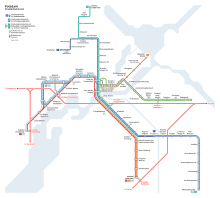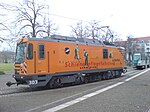Trams in Potsdam
| Potsdam tramway network | |||||||||||||||||||||||||
|---|---|---|---|---|---|---|---|---|---|---|---|---|---|---|---|---|---|---|---|---|---|---|---|---|---|
 A "Tatra KT4" at Nauener Tor | |||||||||||||||||||||||||
| Operation | |||||||||||||||||||||||||
| Locale | Potsdam, Brandenburg, Germany | ||||||||||||||||||||||||
| |||||||||||||||||||||||||
| |||||||||||||||||||||||||
The Potsdam tramway network (
The network is owned and operated by the public citizen company Verkehrsbetrieb Potsdam(ViP), and included in the "Berlin C" fare zone (Tarifbereich Berlin C) of the Verkehrsverbund Berlin-Brandenburg.[1]
History
The network opened on 12 May 1880: It was a horsecar system owned by the society Reymer & Masch, named Potsdamer Straßenbahn-Gesellschaft and consisted of a pair of lines.[2] 1907 saw the introduction of electric trams which ran on a new line of 8 km (5.0 mi).[3] In 1908 the network consisted of 4 lines (named from A to D) and in 1949 of 5 lines (named from 1 to 5).
At the end of the 1950s, new streetcar models were introduced (typical during the
In the 1980s, a pair of new routes were built: in 1984 through the new residential center in
Network



The Potsdam route network is a standard-gauge railway. It is 28.9 kilometres (18.0 mi) long and has 63 stops. The track length is 59.6 kilometres (37.0 mi).[6] It is driven by five main and two amplifier lines. It is almost continuously double tracked, only the Nauener Tor is crossed by means of a gauntlet track.
The network consists, as of June 2022, of 7 lines:[7]
| 91 | Bhf. Rehbrücke
|
| 92 | Bornstedt, Kirschallee ↔ Schlaatz, Bisamkiez (↔ Kirchsteigfeld, Marie-Juchacz-Straße) to Kirchsteigfeld only Saturday and Sunday |
| 93 | Bhf. Rehbrücke
|
| 94 | (Bhf. Pirschheide ↔) Schloss Charlottenhof ↔ Babelsberg, Fontanestraße |
| 96 | Campus Jungfernsee ↔ Kirchsteigfeld, Marie-Juchacz-Straße |
| 98 | ( school holidays
|
| 99 | Babelsberg, Fontanestraße ↔ S Hauptbahnhof (↔ Schlaatz, Bisamkiez) from Bisamkiez only in the morning, to Bisamkiez only in the evening |
The tram lines 91 to 96 operate on all days according to a uniform timetable scheme. This should give passengers better visibility. The basic scheme of the tram lines is a 20-minute-cyclic schedule. The timetable of the tram lines are coordinated at the linking points Potsdam Hauptbahnhof and Babelsberg station with the Berlin S-Bahn.
Lines 98 and 99 are amplifier lines that don´t operate at certain times. They are only a part of the timetable scheme. On Line 92, extra rides are offered throughout the route in the rush hour. As a result, lines 92 (with 2 courses) and 96 (with one course) run at 6/7/7-minute intervals, which in turn means that line 91 and 92 as well as 96 and 93 do not drive at an interval of 10 minutes.
The network is navigated with
Photogallery
-
A "Gothawagen" at Platz der Einheit in 1965
-
Historical 1907 Triebwagen Nr. 9 in 2006
-
A Tatra KT4" at Schragen
-
A "Combino" at Rathaus Babelsberg
-
A "
-
The final Potsdam version of the new "Variotram"
-
A rail maintenance vehicle at Platz der Einheit
See also
References
Notes
- ^ "S+U-Schnellbahn Berlin (Tarifbereich ABC)". Berliner Verkehrsbetriebe. 4 August 2019. Retrieved 13 November 2019.
- ^ ISBN 3-932785-03-7
- ^ "Potsdam Light Rail".
- ^ (in German) Gothawagen in Potsdam
- ^ (in German) History of transport in Potsdam
- ^ "Zahlen und Fakten" (in German). Stadtwerke Potsdam. Archived from the original on 2015-05-27. Retrieved 2015-04-23. Stand 2008
- ^ (in German) Potsdam tram network infos on ViP website
- ^ Note the DVG logo on the vehicle
Bibliography
- Bauer, Gerhard; Kuschinski, Norbert (1995). Die Straßenbahnen in Ostdeutschland [The Tramways in East Germany]. Vol. Band 3: Berlin, Brandenburg, Mecklenburg-Vorpommern [Volume 3: Berlin, Brandenburg, Mecklenburg-Vorpommern]. Aachen, Germany: Schweers + Wall. ISBN 3921679818. (in German)
- Schwandl, Robert (2012). Schwandl's Tram Atlas Deutschland (in German and English) (3rd ed.). Berlin: Robert Schwandl Verlag. pp. 116–117. ISBN 9783936573336.
External links
- Stadtwerke (and Verkehrsbetrieb) Potsdam Archived 2017-11-02 at the Wayback Machine (in German)
- Potsdam Tramway (map, infos, pictures) at urbanrail.net
- Tram Travels: Verkehrsbetrieb Potsdam (ViP)
- Article about Potsdam Tramway at railway-technology.com
- Potsdam database / photo gallery and Potsdam tram list at Urban Electric Transit – in various languages, including English.
- Potsdam database / photo gallery at Phototrans – in various languages, including English.






![A "Variotram" used in Duisburg[8] at Platz der Einheit](http://upload.wikimedia.org/wikipedia/commons/thumb/8/89/Potsdam_Variobahn_am_Platz_der_Einheit.JPG/150px-Potsdam_Variobahn_am_Platz_der_Einheit.JPG)



